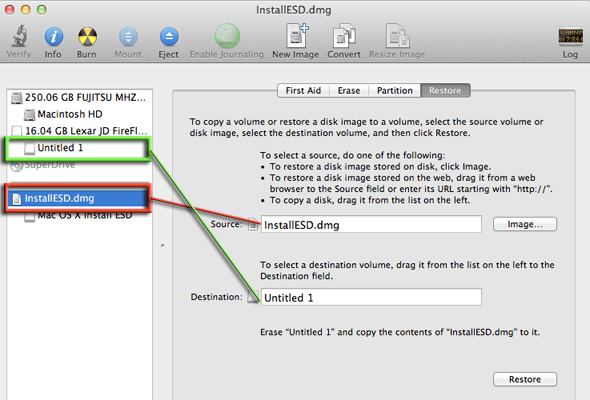- Create Boot Up Drive For Restoring Mac Os 2
- Create Bootup Drive For Restoring Mac Os 10
- Create Boot Up Drive For Restoring Mac Os X To Factory Settings
- Create Bootup Drive For Restoring Mac Os X
- Create Boot Up Drive For Restoring Mac Os X Base System
Mar 12, 2020 After creating the bootable installer, follow these steps to use it. Plug the bootable installer into a compatible Mac.; Use Startup Manager or Startup Disk preferences to select the bootable installer as the startup disk, then start up from it. You set your Mac or Macbook which disk to start up from when more than one startup disk is connected. This works for USB drives including the NinjaStik For 2018 to 2020 Macs with the Secure Boot T2 Chip, see the 2020 Macbook Pro Boot from USB instructions. A “startup disk” is a volume or partition of a drive that contains a bootable operating system. Sep 06, 2019 How do I install OS X on my hard drive using an installation disc? If you have a built-in disc drive, power on your Mac so you can insert the OS X installation disc into the slot. Now power off your Mac from the menu or by holding the power button. Briefly press the power button, then immediately hold the option key while your Mac boots up. Nov 10, 2017 How to Create a Mac OS X USB Boot Drive in Recovery Mode - Duration: 3:45. Kevin Muldoon 133,004 views. How to create a Bootable USB Flash Drive from DMG image in Windows 10. If your Mac is really old - as in so old it's running Mac OS X Snow Leopard or older - it will not have a Recovery partition, the only way to reinstall the OS is to use the discs that shipped with.
Create Boot Up Drive For Restoring Mac Os 2
These advanced steps are primarily for system administrators and others who are familiar with the command line. You don't need a bootable installer to upgrade macOS or reinstall macOS, but it can be useful when you want to install on multiple computers without downloading the installer each time.
Download macOS
Find the appropriate download link in the upgrade instructions for each macOS version:
macOS Catalina, macOS Mojave, ormacOS High Sierra
Installers for each of these macOS versions download directly to your Applications folder as an app named Install macOS Catalina, Install macOS Mojave, or Install macOS High Sierra. If the installer opens after downloading, quit it without continuing installation. Important: To get the correct installer, download from a Mac that is using macOS Sierra 10.12.5 or later, or El Capitan 10.11.6. Enterprise administrators, please download from Apple, not a locally hosted software-update server.
OS X El Capitan
El Capitan downloads as a disk image. On a Mac that is compatible with El Capitan, open the disk image and run the installer within, named InstallMacOSX.pkg. It installs an app named Install OS X El Capitan into your Applications folder. You will create the bootable installer from this app, not from the disk image or .pkg installer.
Use the 'createinstallmedia' command in Terminal
- Connect the USB flash drive or other volume that you're using for the bootable installer. Make sure that it has at least 12GB of available storage and is formatted as Mac OS Extended.
- Open Terminal, which is in the Utilities folder of your Applications folder.
- Type or paste one of the following commands in Terminal. These assume that the installer is still in your Applications folder, and MyVolume is the name of the USB flash drive or other volume you're using. If it has a different name, replace
MyVolumein these commands with the name of your volume.
Catalina:*
Mojave:*
High Sierra:*
El Capitan: - Press Return after typing the command.
- When prompted, type your administrator password and press Return again. Terminal doesn't show any characters as you type your password.
- When prompted, type
Yto confirm that you want to erase the volume, then press Return. Terminal shows the progress as the bootable installer is created. - When Terminal says that it's done, the volume will have the same name as the installer you downloaded, such as Install macOS Catalina. You can now quit Terminal and eject the volume.
* If your Mac is using macOS Sierra or earlier, include the --applicationpath argument, similar to the way this argument is used in the command for El Capitan.

Use the bootable installer
Create Bootup Drive For Restoring Mac Os 10
After creating the bootable installer, follow these steps to use it:
- Plug the bootable installer into a compatible Mac.
- Use Startup Manager or Startup Disk preferences to select the bootable installer as the startup disk, then start up from it. Your Mac will start up to macOS Recovery.
Learn about selecting a startup disk, including what to do if your Mac doesn't start up from it. - Choose your language, if prompted.
- A bootable installer doesn't download macOS from the Internet, but it does require the Internet to get information specific to your Mac model, such as firmware updates. If you need to connect to a Wi-Fi network, use the Wi-Fi menu in the menu bar.
- Select Install macOS (or Install OS X) from the Utilities window, then click Continue and follow the onscreen instructions.
Learn more
For more information about the createinstallmedia command and the arguments that you can use with it, make sure that the macOS installer is in your Applications folder, then enter this path in Terminal:
Create Boot Up Drive For Restoring Mac Os X To Factory Settings
Catalina:
Mojave:
Create Bootup Drive For Restoring Mac Os X
High Sierra:

Create Boot Up Drive For Restoring Mac Os X Base System
El Capitan: